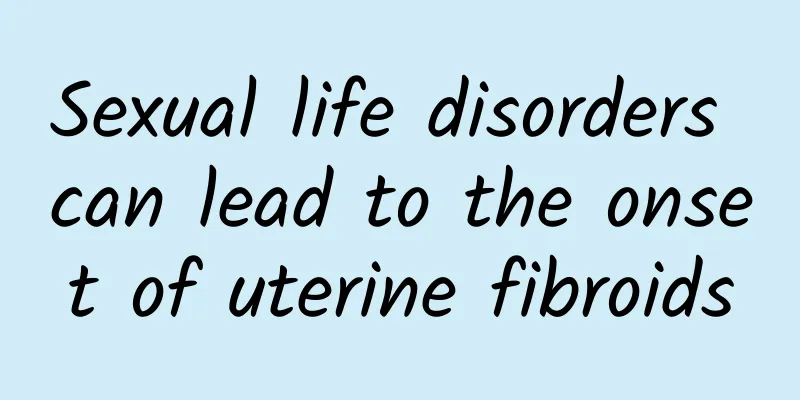What are the sequelae of uterine fibroid bleeding? What kind of blood is uterine fibroid bleeding?

|
What are the sequelae of uterine fibroid bleeding? What kind of blood is uterine fibroid bleeding? Uterine fibroids are one of the common reproductive organ diseases in women, and uterine fibroid bleeding is one of its common complications. When uterine fibroids bleed, it often causes a series of sequelae. So, what are the sequelae of uterine fibroid bleeding? Next, we will discuss this issue in detail and explore what kind of blood uterine fibroid bleeding is. 1. Sequelae of uterine fibroid bleeding 1. Irregular menstruation After uterine fibroids bleed, due to the abnormal discharge of blood, women's menstrual cycles will become irregular. Some women may experience early or delayed menstruation, and may even experience intermittent bleeding. This brings great inconvenience and distress to women's lives. 2. Increased menstrual flow After bleeding from uterine fibroids, menstrual flow often increases significantly. Due to the influence of uterine fibroids, the proliferation of the endometrium increases, resulting in a significant increase in menstrual flow. Women may need more sanitary products during each menstrual period, and some women may even experience anemia and other problems. 3. Abdominal pain and discomfort After uterine fibroids bleed, there will be persistent pain or discomfort in the abdomen due to blood accumulation in the uterus. This is because uterine fibroids increase the size of the uterus, compress nearby tissues and organs, and cause local inflammation and pain. 2. Bleeding from uterine fibroids Bleeding from uterine fibroids is often different from normal menstrual blood. Due to the increased amount of bleeding, bleeding from uterine fibroids often appears dark red or has blood clots. Normal menstrual blood is bright red with no obvious blood clots. Bleeding from uterine fibroids may be heavier and last longer. 3. Prevention and treatment of sequelae of uterine fibroid bleeding In order to prevent and treat the sequelae of uterine fibroid bleeding, women need to seek medical attention and receive professional treatment in time. The following are some prevention and treatment methods: 1. Pay attention to rest, avoid overwork, maintain good living habits and eating habits, and get enough sleep to effectively improve immunity. 2. Actively participate in physical exercise and stick to regular exercise. Moderate exercise can relieve pain and discomfort and help the digestive and circulatory systems. However, strenuous exercise and heavy lifting should be avoided. 3. Drug treatment. According to the doctor's advice, you can consider using some Chinese or Western medicine to relieve symptoms and reduce pain. These drugs can work by regulating hormone levels and improving blood supply to uterine fibroids. 4. Surgical treatment. For some severe cases of uterine fibroid bleeding, surgery may be necessary. Surgery can solve the bleeding problem by removing the uterine fibroid or uterus and avoid sequelae. However, surgical treatment has risks and needs to be carefully considered and performed under the guidance of a professional doctor. The sequelae of uterine fibroid bleeding include irregular menstruation, increased menstrual flow and abdominal pain. The blood from uterine fibroid bleeding is often dark red or contains blood clots. When women face uterine fibroid bleeding, they should seek medical attention in time and take appropriate preventive and therapeutic measures to alleviate symptoms and avoid the occurrence of sequelae. At the same time, regular check-ups and consultations with professional doctors are also very important. |
>>: What foods should I eat more for uterine fibroids?
Recommend
What are the symptoms of pathological ovarian cysts and how to treat them
Patients with pathological ovarian cysts will hav...
Does fasting activate the body's self-healing ability? Japanese experts reveal: 5 keys to anti-aging and disease prevention
Many people who want to lose weight often cannot ...
What is dysmenorrhea in traditional Chinese medicine?
Dysmenorrhea is a common disease for many women. ...
Is 2.8 cm of pelvic fluid considered serious?
Pelvic effusion of 2.8 cm is generally not consid...
Consumer Foundation: The ADI value of clenbuterol is still questionable
The Food and Drug Administration of the Departmen...
Nursing after cone resection of cervical hypertrophy
After cervical hypertrophy cone resection, proper...
How to avoid habitual miscarriage? Pay attention to these 5 aspects
Habitual miscarriage is a nightmare for many wome...
Does pelvic inflammatory disease affect pregnancy?
Does pelvic inflammatory disease affect pregnancy...
5 minutes to relieve menstrual cramps
Dysmenorrhea is really a problem for many female ...
Uterine fibroids usually shrink after menopause. How big a uterine fibroid should be removed?
Uterine fibroids usually shrink after menopause. ...
What to do when menstruation comes
What should I do when my period comes? This is a ...
What are the symptoms of female cervical erosion? These three common clinical manifestations of female cervical erosion
Cervical erosion is a very common gynecological d...
Can endometrial thickening be cured without surgery?
Can endometrial thickening be cured without surge...
Which is better for women, surgical abortion or medical abortion? The choice of surgical abortion or medical abortion mainly depends on these two points
As relationships between people are becoming more...
Treatment methods for irregular menstruation in patients with different constitutions
Menstruation is a normal physiological phenomenon...









